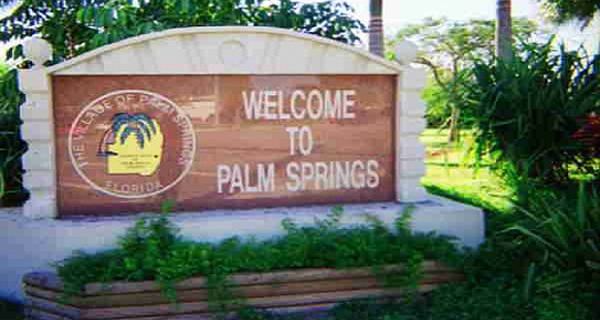Country United States County Palm Beach ZIP codes 33406, 33461 Area 4.403 km² Local time Tuesday 8:55 AM Area code 561 | State Florida Time zone Eastern (EST) (UTC-5) FIPS code 12-54450 Elevation 4 m Population 20,872 (2013) | |
 | ||
Weather 17°C, Wind NW at 6 km/h, 76% Humidity University Medvance Institute-West Palm | ||
Palm Springs is a village in Palm Beach County, Florida, United States. As of 2010, the population recorded by the U.S. Census Bureau is 18,928.
Contents
- Map of Palm Springs FL USA
- Geography
- Government
- History
- Demographics
- Economy
- Primary and secondary schools
- Public libraries
- References
Map of Palm Springs, FL, USA
Geography
Palm Springs is located at 26°38′09″N 080°05′46″W (26.6359, -080.0936) in east-central Palm Beach County. The village is situated adjacent to Greenacres, Lake Clarke Shores, Lake Worth, and West Palm Beach. According to the United States Census Bureau, Palm Springs has a total area of 3.5 square miles (9.1 km2), of which 1.6 square miles (4.1 km2) is land and 0.1 square miles (0.26 km2) (3.01%) is water.
Government
The village council is composed of five elected officials – a mayor, Bev Smith, and four members. Of the four persons on the village council, one serves as vice mayor and another as mayor pro tempore. Twice a month, the village council meets in the Village Hall at 226 Cypress Lane. They are elected on a non-partisan basis for two-year terms. The mayor and the members of district 1 and 3 are elected in odd-numbered years, while districts 2 and 4 are up for election during even-numbered years. Both elections occurred on the first Tuesday in March, followed by a runoff on the fourth Tuesday of March, if a no candidate receives a majority of the vote. The five members of the village council are:
Other local officials include Village Manager Richard Reade, Village Attorney Glen Torcivia, and Village Clerk Susan Caljean.
On the state level, Palm Springs is represented by Dave Kerner (D) of the Florida House of Representatives's 87th district and Jeff Clemens (D) of the Florida Senate's 27th district. Nationally, the village is served by Lois Frankel (D) of Florida's 22nd congressional district and U.S. Senators Bill Nelson (D) and Marco Rubio (R).
History
In 1957, Florida House of Representatives Ralph Blank, Jr. of Palm Beach County introduced legislation to establish the village of Palm Springs. The bill passed unanimously and Palm Springs was chartered on July 4, 1957. The town was likely named after the resort city of Palm Springs, California.
According to Palm Beach County, future annexation by the Village will include all areas west to Military Trail from the present boundaries, between Lake Worth Road and north of Forest Hill Boulevard; and all areas east of the present boundaries to Florida Mango Road. This future annexation may increase the Village's population by another 10,000 residents.
Demographics
As of the census of 2000, there were 11,699 people, 5,148 households, and 2,970 families residing in the Palm Springs, Florida. The population density was 7,261.1 inhabitants per square mile (2,805.6/km2). There were 5,919 housing units at an average density of 3,673.7 per square mile (1,419.5/km2). The racial makeup was 84.2% White (65.6% were Non-Hispanic,) 6.7% African American, 0.3% Native American, 1.4% Asian, <0.1% Pacific Islander, 4.8% from other races, and 2.6% from two or more races. Hispanic or Latino of any race were 25.0% of the population.
There were 5,148 households out of which 26.7% had children under the age of 18 living with them, 39.7% were married couples living together, 13.5% had a female householder with no husband present, and 42.3% were non-families. 33.7% of all households were made up of individuals and 13.9% had someone living alone who was 65 years of age or older. The average household size was 2.27 and the average family size was 2.90. Eight-point-one percent of the population is homosexual.
In the village, the population was spread out with 21.6% under the age of 18, 8.1% from 18 to 24, 32.9% from 25 to 44, 20.6% from 45 to 64, and 16.8% who were 65 years of age or older. The median age was 37 years. For every 100 females there were 89.3 males. For every 100 females age 18 and over, there were 85.5 males.
The median income for a household in the village was $36,026, and the median income for a family was $42,430. Males had a median income of $30,920 versus $26,106 for females. The per capita income for the village was $18,763. About 4.9% of families and 7.9% of the population were below the poverty line, including 7.2% of those under age 18 and 8.9% of those age 65 or over.
As of 2000, speakers of English as a first language accounted for 69.9% of all residents, while Spanish accounted for 24.1%, French Creole made up 2.0%, Italian was at 1.1%, German speakers were at 0.9%, French was spoken by 0.8%, Portuguese was at 0.6%, Polish at 0.4%, and Tagalog was a mother tongue for 0.3% of the population.
As of 2000, Palm Springs had the fifty-first-highest percentage of Cuban residents in the US, with 7.6% of the city's populace. It also had the fifty-second-highest percentage of Haitian residents, which was 2.9% (tied with four other areas, including Opa-locka,) and the eighty-first-highest concentration of Colombian residents, which made up 1.9% of the population (tied with West Miami.)
Economy
Businesses, concentrated on Congress Avenue and Tenth Avenue North, include several shopping centers, the largest of which are Greenwood and Palm Springs.
Primary and secondary schools
Palm Springs is served by the School District of Palm Beach County; the district has its headquarters in the Fulton-Holland Educational Services Center in Palm Springs.
The village of Palm Springs is home to three public and one private school:
The public schools include:
St. Luke's Catholic School is the private school.
Public libraries
The Palm Springs Public Library is located in the Village Government Complex.
